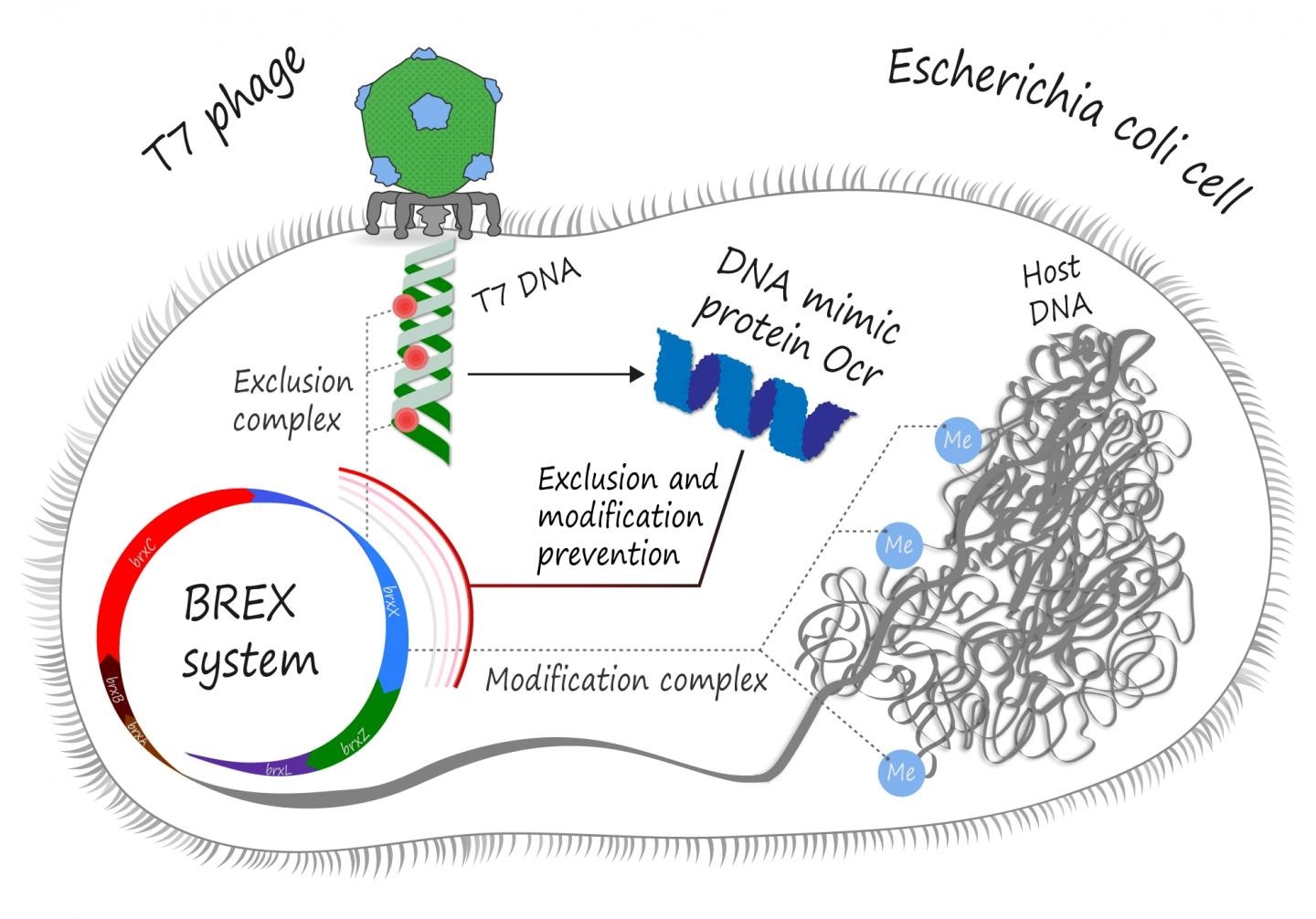A research team from the Severinov Laboratory at Skoltech, together with their collaborators from Israel and Switzerland, has analyzed a bacterial BREX defense mechanism that was poorly studied to date.

Ocr, a DNA mimic protein of the well-studied T7 phage, can protect the virus from BREX (bacteriophage exclusion), a poorly studied set of bacterial defense mechanisms utilized by, among others, Escherichia coli, which T7 commonly infects. Image Credit: Pavel Odinev/Skolkovo Institute of Science and Technology.
The researchers’ aim is to demonstrate that this defense mechanism can be “turned off” by a versatile viral protein that effectively impersonates DNA. The study was published in the Nucleic Acids Research journal.
In the endless war between bacteria and viruses that infect the former, it is very crucial to know the location of DNA. Bacteria protect themselves from the hostile invasion by “marking” their own genetic material, that is, by methylating it at particular genomic sites.
The entire “unmarked” DNA, like that of a bacteriophage, is subsequently detected, cleaved, and decomposed by a large group of endonucleases. These are known as restriction-modification (RM) systems.
Then, with the help of DNA mimic proteins, these phages consequently learn to dodge these RM systems. Here, a specific protein that chemically “looks” like DNA can bind the bacterial restriction complex and stop it from ever reaching the true phage DNA.
Artem Isaev, a Ph.D. student from Skolkovo Institute of Science and Technology (Skoltech), and his collaborators from Philip Morris International R&D and Tel Aviv University have revealed that Ocr, a DNA mimic protein of the extensively researched T7 phage, is actually a versatile tool.
Ocr not only inhibits the RM type I systems but also protects the phage from bacteriophage exclusion (BREX), which is another set of bacterial defense mechanisms used by, among others, Escherichia coli, which are commonly infected by the T7 phage.
Five years ago, we knew about restriction modification, CRISPR and Toxin-Antitoxin abortive infection systems, but recently bioinformatics has shown us that it is just a small proportion of the real diversity of defensive strategies employed by bacteria to cope with phage infections.”
Artem Isaev, PhD Student, Skolkovo Institute of Science and Technology
Isaev continued, “BREX was the first in a row of novel phage defense systems. They are found in around 1 in 10 of all microorganisms, and in bacteria, they are even more widespread than CRISPR. Yet we still don't know the function of five out of six BREX genes and how they are working together to provide protection.”
It is still not known whether BREX merely kills the inbound phage DNA or prevents its replication by some other means, but all BREX mechanisms use an enzyme called BrxX methyltransferase that is responsible for “marking” the bacterial DNA for self-recognition.
Evidently, the OCR protein adheres to this methyltransferase, and thus inhibits the BREX system from methylation of the host DNA and also from damaging the non-methylated phage genome.
We have shown that OCR interacts with methyltransferase and inhibits host DNA methylation. In theory, this can lead to an autoimmune response: as host DNA is no longer "marked" as such, BREX exclusion complexes should attack it. Yet, we do not see self-toxicity after expression of OCR, which indicates that OCR inhibits these exclusion complexes as well, and thus BREX methyltransferase should be involved at the active stage of defense.”
Artem Isaev, PhD Student, Skolkovo Institute of Science and Technology
Isaev continued, “OCR is already known as an inhibitor of type I RM systems, and these systems also require methyltransferase for restriction complexes. There are other similarities between BREX and RM systems, and we hope that they would help us understand how BREX functions.”
Since other DNA mimic proteins do not appear to tackle the BREX defense, the scientists are planning to further study the exact way Ocr performs its task. Since bacterial defense systems largely tackle the recognition and manipulation of DNA, they can serve as robust tools in the fields of molecular biology and medicine.
Due to the discovery and description of the RM systems, molecular cloning is now feasible, while the CRISPR technique has also ushered in genome editing.
Furthermore, examining the arsenals of both phages and bacteria may prove handy in “recruiting” the viruses as new antimicrobial agents in the fight against bacteria that are resistant to antibiotics.
Bacteria have been combatting phages for more than a billion years, and this constant ‘arms race’ is one of the major evolutionary forces in the microworld. Both sides have developed an enormous arsenal of strategies to fight each other, and a great diversity of molecular machines has been invented in the process. For me personally, it's just fascinating to study what else is hidden in the genome and what novel mechanism we can discover in the process.”
Artem Isaev, PhD Student, Skolkovo Institute of Science and Technology
Source:
Journal reference:
Isaev, A., et al. (2020) Phage T7 DNA mimic protein Ocr is a potent inhibitor of BREX defence. Nucleic Acid Research. doi.org/10.1093/nar/gkaa290.